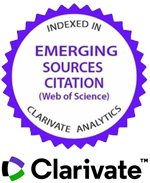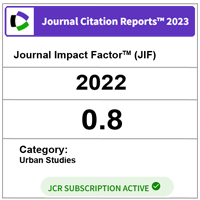Urban Design Initiatives in Drought-prone Areas dealing increasing Water Demand as Pandemic Covid-19 Impact
DOI:
https://doi.org/10.11113/ijbes.v9.n2-2.1027Keywords:
Drought, Covid-19, water demand, urban designAbstract
The Covid-19 pandemic becomes a primary issue in urban development that requires several supporting facilities and infrastructures to handle. The adequate water supply to ensure the washing hand and bathing as part of health protocol implementation is crucial for drought-prone areas. Meanwhile, the government strategies on drought handling by assisting the water trucks are considered a temporary solution. Hence, this study examines urban design initiatives to deal with Covid-19 impact on the water sector, particularly in Semarang drought-prone areas. The research used a quantitative method by overlaying physical variables such as the soil type, slope, and water supply coverage to determine the drought level map. Afterward, the drought level compared with the population growth and community's economic capacity to describe the area's vulnerability. Besides, the existing drought handling strategies were analyzed to examine the impact. This study utilized secondary data such as the government institution websites as well as Google maps. The analysis results point out that most of drought-prone areas did not serve by government water service and relied on the community-based water supply system. In addition, 25% of the inhabitants are categorized as a low-income community, so that they prefer to take water from the river or spring than have to expend more to buy the water. Meanwhile, the existing initiatives on drought handling did not have significant impacts because of a lack of knowledge and unclear regulation. The Water Sensitive Urban Design (WSUD) concept has already been adopted, yet the implementation was still small-scale and unsustained. Therefore, it is necessary to consider the physical, socio-economic, and political aspects in implementing the drought handling initiatives.
References
Alwaer, H., Speedie, J., & Cooper, I. (2021). Unhealthy neighbourhood “syndrome”: A useful label for analysing and providing advice on urban design decision-making? Sustainability (Switzerland), 13(11). https://doi.org/10.3390/su13116232
Anim, D. O., & Ofori-Asenso, R. (2020). Since January 2020 Elsevier has created a COVID-19 resource centre with free information in English and Mandarin on the novel coronavirus COVID- 19 . The COVID-19 resource centre is hosted on Elsevier Connect , the company ’ s public news and information. Journal of Infection, 81(January), e108–e109.
Bellizzi, S., Napodano, P., Fiamma, M., & Maher, O. A. (2020). Since January 2020 Elsevier has created a COVID-19 resource centre with free information in English and Mandarin on the novel coronavirus COVID- 19 . The COVID-19 resource centre is hosted on Elsevier Connect , the company ’ s public news and information. Public Health, 183(January), 46–47.
BNPB Indonesia. (2016). Risiko bencana indonesia.
Central Bureau of Statistics Semarang City (BPS). 2019. Curah Hujan Kota Semarang 2016-2018. https://semarangkota.bps.go.id/indicator/151/79/1/curah-hujan-kota-semarang.html. Accessed on 17 August 2021.
Central Bureau of Statistics Semarang City (BPS).2021. Semarang City in Figures 2021. https://semarangkota.bps.go.id/publication/2021/02/26/cf7000f79cd1c7015c2939fc/kota-semarang-dalam-angka-2021.html. Accessed on 17 August 2021.
Chien, L. C., & Chen, L. W. (2020). Meteorological impacts on the incidence of COVID-19 in the U.S. Stochastic Environmental Research and Risk Assessment, 34(10), 1675–1680. https://doi.org/10.1007/s00477-020-01835-8
Cotterill, S., Bunney, S., Melville-shreeve, P., Lawson, E., Chisholm, A., & Farmani, R. (2020). COVID-19 and the water sector : understanding impact , preparedness and resilience in the UK through a sector-wide survey. 1, 715–728. https://doi.org/10.1111/wej.12649
Development Planning Agency Semarang City (Bappeda). Regional Long-Term Development Plan (RPJPD) Semarang City Document 2005-2025.
Development Planning Agency Semarang City (Bappeda). Water Supply System Master Plan (RISPAM) Semarang City Document 2018-2038.
de Waegemaeker, J., Van Acker, M., Kerselaers, E., & Rogge, E. (2016). Shifting climate, reshaping urban landscapes: Designing for drought in the Campine landscape. Journal of Landscape Architecture, 11(3), 72–83. https://doi.org/10.1080/18626033.2016.1252173
Haysom, G. (2021). Integrating Food Sensitive Planning and Urban Design into Urban Governance Actions. Urban Forum, (0123456789). https://doi.org/10.1007/s12132-021-09417-9
Information Management and Documentation Officer (PPID). 2021. COVID-19 Microzonation Map Semarang City. https://ppid.semarangkota.go.id/peta-microzonasi-sebaran-covid-19-berdasarkan-wilayah-kota-semarang/. Accessed on 18 August 2021.
Keulertz, M., Mulligan, M., & Allan, J. A. (2020). The impact of COVID-19 on water and food systems : flattening the much bigger curve ahead. Water International, 45(5), 430–434. https://doi.org/10.1080/02508060.2020.1779515
Lee, K., & Jepson, W. (2020). Drivers and barriers to urban water reuse: A systematic review. Water Security, 11(August), 100073. https://doi.org/10.1016/j.wasec.2020.100073
Lottering, N., du Plessis, D., & Donaldson, R. (2015). Coping with drought: The experience of water sensitive urban design (WSUD) in the George Municipality. Water SA, 41(1), 1–8. https://doi.org/10.4314/wsa.v41i1.1
Mishra, A., Bruno, E., & Zilberman, D. (2021). Compound natural and human disasters: Managing drought and COVID-19 to sustain global agriculture and food sectors. Science of the Total Environment, 754, 142210. https://doi.org/10.1016/j.scitotenv.2020.142210
Morison, P. J., & Brown, R. R. (2011). Understanding the nature of publics and local policy commitment to Water Sensitive Urban Design. Landscape and Urban Planning, 99(2), 83–92. https://doi.org/10.1016/j.landurbplan.2010.08.019
Patemon District Government. 2018. Wisata Embung Patemon. http://patemon.semarangkota.go.id/gallery/embungpatemon. Accessed on 18 August 2021
Radio Republik Indonesia (RRI) Semarang. 2020. Pemkot Semarang akan Bangun Empat Embung. https://rri.co.id/semarang/1144-daerah/770520/pemkot-semarang-akan-bangun-empat-embung. Accessed on 18 August 2021.
Regional Disaster Management Agency Semarang City (BPBD). 2011. Disaster-Prone Areas. http://bpbd.semarangkota.go.id/pages/daerah-rawan-bencana. Accessed on 17 August 2021.
Regional Disaster Management Agency Semarang City (BPBD). 2016. Rencana Strategis BPBD 2016-2021. https://bappeda.semarangkota.go.id/packages/upload/materi/ofjoKfGO0B.pdf. Accessed on 18 August 2021.
Semarang Government. (2016). Semarang Tangguh: Bergerak Bersama Menuju Semarang Tangguh.
Sivakumar, B. (2020). COVID-19 and water. Stochastic Environmental Research and Risk Assessment, 35(3), 531–534. https://doi.org/10.1007/s00477-020-01837-6
Sowby, R. B. (2020). Emergency preparedness after COVID-19 : A review of policy statements in the U . S . water sector. Utilities Policy, 64(April), 101058. https://doi.org/10.1016/j.jup.2020.101058
Subardja, D. S., Ritung, S., Anda, M., Sukarman, Suryani, E., & Subandiono, R. E. (2016). Klasifikasi Tanah Nasional. Retrieved from http://bbsdlp.litbang.pertanian.go.id/ind/index.php/publikasi-3/petunjuk-teknis?download=21:klasifikasi-tanah-nasional
The Ministry of Environment Regulation No.12 of 2009 about Rainwater Utilization.
Wang, P., Qiao, W., Wang, Y., Cao, S., & Zhang, Y. (2020). Urban drought vulnerability assessment – A framework to integrate socio-economic, physical, and policy index in a vulnerability contribution analysis. Sustainable Cities and Society, 54(July 2019), 102004. https://doi.org/10.1016/j.scs.2019.102004
Warner, M. E., Zhang, X., & Rivas, M. G. (2020). Which states and cities protect residents from water shutoffs in the COVID-19 pandemic? Utilities Policy, 67(August). https://doi.org/10.1016/j.jup.2020.101118
WHO. (2020). Water, sanitation, hygiene, and waste management for SARS-CoV-2, the virus that causes COVID-19. Interim Guidance, (29 July), 1–11. Retrieved from https://www.who.int/publications/i/item/water-sanitation-hygiene-and-waste-management-for-the-covid-19-virus-interim-guidance
Zvobgo, L., & Do, P. (2020). COVID-19 and the call for ‘Safe Hands’: Challenges facing the under-resourced municipalities that lack potable water access - A case study of Chitungwiza municipality, Zimbabwe. Water Research X, 9, 100074. https://doi.org/10.1016/j.wroa.2020.100074
Downloads
Published
How to Cite
Issue
Section
License

This work is licensed under a Creative Commons Attribution-NonCommercial-ShareAlike 4.0 International License.
Copyright of articles that appear in International Journal of Built Environment and Sustainability belongs exclusively to Penerbit Universiti Teknologi Malaysia (Penerbit UTM Press). This copyright covers the rights to reproduce the article, including reprints, electronic reproductions or any other reproductions of similar nature.
Authors who publish with this journal agree to the following terms:
- This Journal applies Creative Commons Licenses of CC-BY-NC-SA
- Authors retain copyright and grant the journal right of publication with the work simultaneously licensed under a Creative Commons Attribution License that allows others to share the work with an acknowledgement of the work's authorship and publication in this journal.
- Authors are able to enter into separate, additional contractual arrangements for the non-exclusive distribution of the journal's published version of the work (e.g., post it to an institutional repository or publish it in a book), with an acknowledgement of its publication in this journal.
- Authors are permitted and encouraged to post their work online (e.g., in institutional repositories or on their website) prior to and during the submission process, as it can lead to productive exchanges, as well as earlier and greater citation of published work (See The Effect of Open Access).








